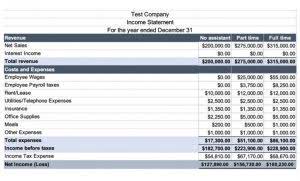
The allowance can accumulate across accounting periods and may be adjusted based on the balance in the account. In footnote 3, the company reports, “Net property and equipment includes accumulated depreciation and amortization of $25.3 billion as of August 1, 2021 and $24.1 billion as of January 31, 2021.” A contra account enables a company to report the original amount while also reporting the appropriate downward adjustment. Accounting software can simplify the management of and reporting from your ledger. With the appropriate level of automation integration in your chosen tool, you can pull the relevant values into these individual accounts directly from invoices, credit agreements, and other documentation.

Is accounts receivable or payable harder?

This indicates that out of $100,000 sales, your customers return goods valued at $500. Accounts receivable is rarely reported on the balance sheet at its net amount. Instead, it is reported at its full amount with an allowance for bad debts listed below it. Maybe more importantly, it shows investors and creditors what percentage of receivables the company is writing off.
How to Account for the Allowance for Doubtful Accounts
For example, a building is acquired for $20,000, that $20,000 is recorded on the general ledger while the depreciation of the building is recorded separately. Get instant access to video lessons taught by experienced investment bankers. In this article, we’re going on a deep dive into what exactly a contra account is, how contra accounts work, why and how you would use contra accounts and more.

What is a contra revenue account?
This general structure can be applied across all contra types, so if the parent account has a credit, the contra account will have a debit. Similarly, if the parent account lists entries as debits, the contra account will appear as a credit. To compensate for those potential deadbeat customers, you can use a Bad Debts account to serve as a contra for your A/R. There is the existence of contra accounts in accounting which are accounts that have the purpose of decreasing the value of another specific account if the two accounts are netted or summed together.
- Contra revenue is a general ledger account with a debit balance that reduces the normal credit balance of a standard revenue account to present the net value of sales generated by a business on its income statement.
- The Allowance for Doubtful Accounts is directly related to the asset account entitled Accounts Receivable.
- Another common contra liability account is a Discount on Bonds Payable account used by businesses that issue their own bonds.
- Contra entry also refers to the offset between accounts receivable and accounts payable of two separate company.
- The contra asset account Accumulated Depreciation is deducted from the related Capital Assets to present the net balance on the parent account in a company’s balance sheet.
A contra account is a general ledger account with a balance that is the opposite of another, related account that it is paired with. The B/S impact is where the contra liability comes into play, i.e. the historical value of the debt is not impacted by the OID. Emilie is a Certified Accountant and Banker with Master’s in Business and 15 years of experience in finance and accounting from corporates, financial services firms – and fast growing start-ups. Contra liability accounts are mainly used by corporations that issue bonds frequently. That is because some of the bonds are issued at a discount, so this reduces the balance of their bonds payable. Contra accounts are used to reduce the original account directly, keeping financial accounting records clean.
Contra Entry Journal

The difference between an asset’s balance and the contra account asset balance is the book value. These three types of contra accounts are used to reduce liabilities, equity, and revenue which all have natural credit balances. Therefore, for these three, the debit balance actually represents a negative amount. A debit will be made to the bad debt expense for $4,000 to balance the journal entry. Although the accounts receivable is not due in September, the company still has to report credit losses of $4,000 as bad debts expense in its income statement for the month.

Why are contra asset accounts important for businesses?
By keeping the original dollar amount intact in the original account and reducing the figure in a separate account, the financial information is more transparent for financial reporting purposes. For example, if a piece of heavy machinery is purchased for $10,000, that $10,000 figure is maintained on the general ledger even as the asset’s depreciation is recorded separately. Accounts Receivable (AR) can be harder because it involves actively managing collections from customers, addressing disputes, and minimizing bad debts. Ensuring timely payments and maintaining customer relationships can be challenging. Accounts Payable (AP), while also important, generally involves tracking invoices and scheduling payments, which is more straightforward but still requires attention to detail to avoid late fees or errors. Consider a business that offers an early payment discount to its customers, cutting their invoiced total by 3% if they pay within 1 week of invoicing.
- Note that in accounting, the term “book value” is also used interchangeably with net value.
- Other than the above contra-asset accounts, we often see contra-revenue accounts for any sales returns or sales rebates.
- Charlene Rhinehart is a CPA , CFE, chair of an Illinois CPA Society committee, and has a degree in accounting and finance from DePaul University.
- They are useful in preserving the historical value in the main account while presenting a write-down or decrease in a separate contra account that nets to the current book value.
- These accounts will typically help track sales discounts, product returns, and allowances (e.g., a price reduction for a good with minor defects).
Examples of Contra Revenue Accounts
The net amount is often referred to as the carrying amount or perhaps the net realizable amount. When accounting for assets, the difference between the asset’s account contra expense account balance and the contra account balance is referred to as the book value. There are two major methods of determining what should be booked into a contra account.

